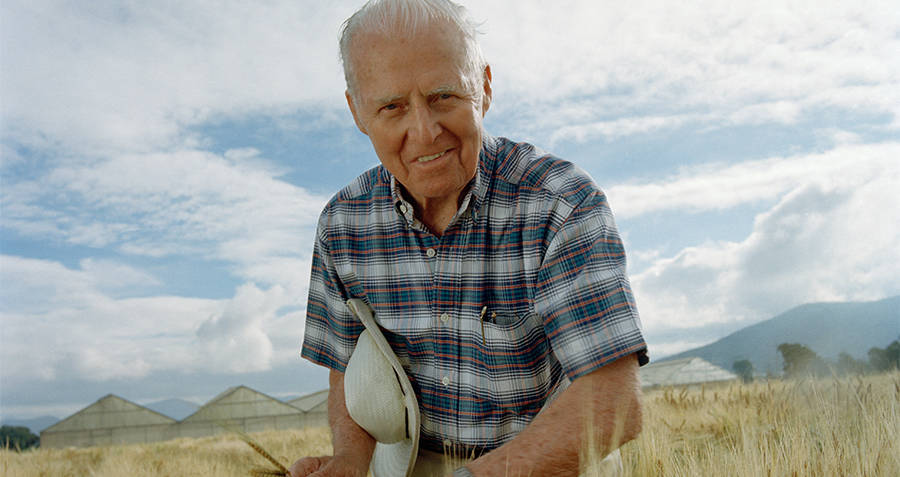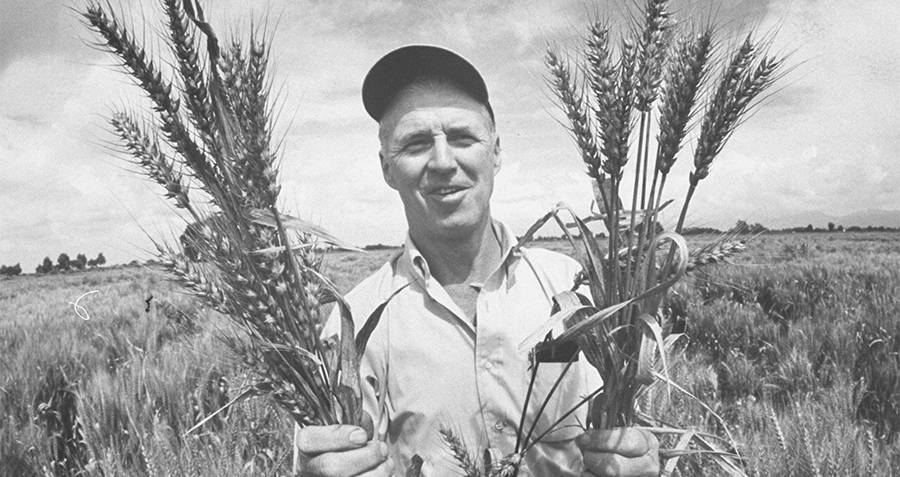Known as the "father of the Green Revolution," Norman Borlaug pushed the boundaries of agriculture and saved over a billion lives in the process.

Getty Images
Norman Borlaug posing in one of his wheat fields
Few scientists have won as many awards as Norman Borlaug, but even fewer scientists deserve them as much as he does. After all, not many scientists have been credited with saving over a billion lives worldwide.
Borlaug was an agronomist, specializing in plant life with a background in forestry. Upon his graduation, he became a leader of the Green Revolution, a wave of initiatives that over a 30 year period ensured the survival of developing nations by increasing worldwide agricultural production.
After graduating from the University of Minnesota in 1942, with a bachelors degree in forestry and a masters degree in plant pathology and genetics, Borlaug moved to Mexico to begin studying and researching plants. His hope was that he could create some sort of sustainable agriculture that could be implemented worldwide.
Within a few years, he had done just that. He’d developed a disease-resistant strain of wheat that could yield high numbers of plants and was a hearty grower. He then realized that by combining modern agricultural production techniques, the strain of wheat could be introduced to developing nations such as Mexico, India, and Pakistan.

Getty ImagesBorlaug holding up bushels of his new wheat strain.
Before long, Mexico became a net exporter of wheat. A few years later, wheat had doubled in Pakistan and India; as a result, food security was had greatly improved.
The introduction of these hearty, disease-resistant wheat strains sparked what is now known as the Green Revolution. Prior to Norman Borlaug’s intervention, it had been predicted that most of the population of the entire Indian subcontinent would be dead before 1980.
The population was growing at a faster rate than their resources could keep up with. It was only thanks to the Green Revolution that the people managed to survive. It is estimated that without Norman Borlaug’s work, over a billion people would have died.
In 1964, Borlaug was named the director of the International Wheat Improvement Program, as well as the Consultative Group on International Agricultural Researches International Maize and Wheat Improvement Center (CIMMYT).
He served for 13 years as president, before stepping down to senior consultant. During his 13 years at CIMMYT, the company expanded their research to include triticale, barley, maize, and sorghum.
After stepping down from CIMMYT, Borlaug co-founded the World Cultural Council, which aims to promote cultural values, goodwill, and philanthropy.
For his contribution to humanitarian efforts and the heightened world food supply, Borlaug was awarded the Nobel Peace Prize in 1970. But, his efforts were far from over.
Borlaug also used his agricultural research to contribute to efforts against deforestation. In what is now known by agriculturalists as the “Borlaug hypothesis,” Borlaug theorized that if farmland production could be increased on the best farmlands, then deforestation would be decreased, as there would be no need to clear woods to create new farmland.
Though this theory only holds true in places where deforestation is used to create farmland, as opposed to building cities, the hypothesis is still widely circulated in the agricultural community.

Wikimedia CommonsNorman Borlaug receiving the Congressional Gold Medal in 2007.
In the early 80’s African countries began to experience the same kinds of famine and starvation that India had been seeing in the 60’s. Seeing that Borlaug’s efforts had effectively solved the problem in India and Pakistan, the director of the Nippon Foundation contacted Borlaug and helped him set up the Sasakawa Africa Association, in an effort to up not only wheat production but sorghum and cowpea production as well.
Though his work was, at times, riddled with controversy, for instance when he suggested that genetically modified foods were the only way to ensure the survival of humans, he is widely considered to be one of the world’s finest agriculturalists.
In addition to his Nobel Prize, Norman Borlaug was awarded the Presidential Medal of Freedom, the National Medal of Science, the Congressional Gold Medal, and the Padma Vibhushan, the second-highest civilian award of the Republic of India.
Enjoy this article on the Green Revolution? Next, check out the newest gardening trend known as vertical gardens. Then, take a look at this stunning Japanese garden.




